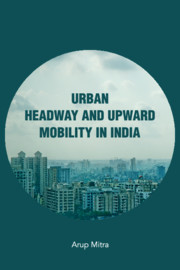Book contents
- Frontmatter
- Contents
- List of Tables
- Acknowledgements
- 1 Analytical Frame
- 2 Assessing the Quality of Cities and Towns
- 3 New Patterns and New Strategies in Indian Urbanization
- 4 Growth, Informal Sector Employment and Poverty
- 5 Upward Mobility of the Disadvantaged Sections
- 6 Erosion of the Caste Factor?
- 7 Changes in a Cultural Variable
- Bibliography
- Index
6 - Erosion of the Caste Factor?
Published online by Cambridge University Press: 30 April 2020
- Frontmatter
- Contents
- List of Tables
- Acknowledgements
- 1 Analytical Frame
- 2 Assessing the Quality of Cities and Towns
- 3 New Patterns and New Strategies in Indian Urbanization
- 4 Growth, Informal Sector Employment and Poverty
- 5 Upward Mobility of the Disadvantaged Sections
- 6 Erosion of the Caste Factor?
- 7 Changes in a Cultural Variable
- Bibliography
- Index
Summary
Introduction
Though in his book Kuznets (1966) had considered fifteen characteristics to define modern economic growth he later compressed them into the now famous six characteristics, falling into three main groups: (1) aggregate growth (a. high rates of increase in per capita product, accompanied by substantial rats of population growth and b. high rates of increase in output per unit of all inputs), (2) structural transformation (c. a high degree of structural transformation, encompassing a shift from agriculture to industry and services and d. changes in the structure of society and its ideology, including urbanization and secularization), and (3) international spread (e. opening up of international communications and f. a growing gap between developed and underdeveloped nations). Quite clearly he envisaged social changes alongside economic transformations. More specifically, urbanization and modernization of thoughts and ideology are seen as concomitant phenomena. The functioning of the rural labour market may be largely caste-based, but that is expected to get faint in the urban job market (Mitra, 2006). In other words, urbanization follows and results in commercialization, which in turn is likely to erode the influence of the caste factor in the job market although the job seekers may access information pertaining to the urban labour market on the basis of caste and kinship bonds (Banerjee, 1986; Desai, 1984; Mitra, 2003). From this point of view it becomes pertinent to assess if the caste factor which remained deep-rooted in the Indian social system for centuries started subsiding after the economic growth and development started off in the post-Independence era. In this chapter we try to examine if within the universe of the low-income households (slums) the caste factor matters or all social categories are equally vulnerable.
Many argued that the disadvantaged (social) classes usually get uprooted from the rural areas and strive hard in an alien urban situation to access livelihood sources (Singh and D’Souza, 1980). However, in an anonymous urban space the caste factor is usually expected to get blurred and, hence, caste-based occupations which might have been pursued in the rural setup prior to migration may change significantly, implying availability of jobs in the urban labour market being independent of caste. Similarly non-availability of jobs may also cut across castes.
- Type
- Chapter
- Information
- Urban Headway and Upward Mobility in India , pp. 119 - 140Publisher: Cambridge University PressPrint publication year: 2020



